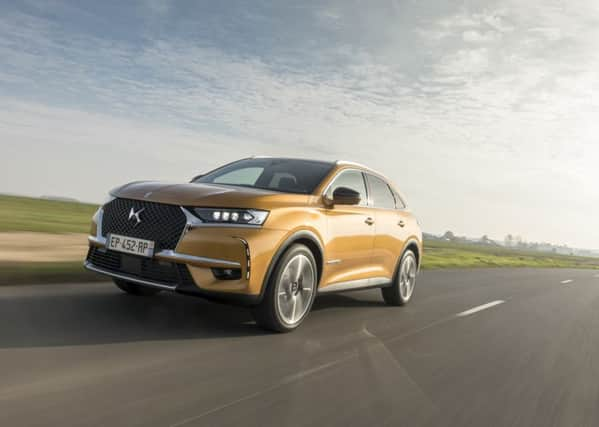Review: DS7 Crossback


I went looking in France. Within a few miles after docking in St Malo I saw the first of several “Sevens”. It was silver. Mine was Nera (sic) black. Lighter colours are more flattering to the shape. The route ended in Santander, on the north Spanish coast, for carriage to Portsmouth with Brittany Ferries.
The DS7 is the first model from DS Automobiles to begin as a fresh start and the largest so far. Its quality and furnishings and general trappings are upscale, to compete with the de luxe models mentioned above. Prices start at £28,000 but most cost more than £33,000 and my super-duper, top chien demo was £44,350.
Advertisement
Hide AdAdvertisement
Hide AdIts kennel name was the Ultra Prestige Blue HDi 180 EAT8 in Opera trim. Unpacking this title reveals the top specification of interiors, wheels, and the 180-horsepower 2-litre diesel engine with an eight-speed automatic gearbox. Opera is one of three trims named after locations in Paris
Although all-new, the DS7 is composed of many parts you’ll find in Peugeot and Citroën cars. DS Automobiles is a plush partner of Citroën which in turn is in Peugeot’s PSA group. The DS7 is made in Peugeot’s Mulhouse factory in north-eastern France.
The interior of the car has large and small diamond cues in the digital instruments, the switches, the silvery panels around the gear lever. Seat comfort was exemplary – another French talent – and this model had various massage treatments including “cat’s paw” which was more like a mild punch.
The diamond theme is used in the extraordinary multi-beam LED headlamps, which go though a rotation of beams when you unlock the car at night. Hey, look at my car, folks. All present and correct, sir.
On the road the rays track hither and thither, adjusting to the road width and contours. On hairpin bends this can all get a bit much – but you can disable them. They are bright yet caused only a few flash-backs from oncoming cars.
As a load carrier it can only do so much – governed by its overall length, which at 180 inches is somewhere between a Ford Focus and a Mondeo. The rear seats fold flat easily but are heavy to get back up. There’s a useful protected storage area between the spare wheel and the floor proper. I’d have liked the tailgate to open wider. I’d also have expected a head-up display, but it’s not even an option.
The car is still finding its place on French roads and attracted attention. The French customs police near the Spanish border described the car as a Citroën. They were looking for excess wine.
There’s not much they can do about the Spanish diesel in the tank. It’s around 15p a litre cheaper than in France. The best price was around £1.20 a litre – that’s 20p more than a year ago.
Advertisement
Hide AdAdvertisement
Hide AdThe car’s touring economy was lower than expected. DSA quotes a combined figure of 57.6mph, extra urban 64.2 and urban 50.4. The average for the entire trip was around 42 miles a gallon. A similar itinerary last year in a 150hp Skoda Octavia automatic returned an average of 58mpg.
Most of the time the DS7 was heavily loaded but driven economically. The high was 50mpg from home to Portsmouth. The low was just 36mpg, when unloaded, on local routes in the Dordogne. This is where I tried to unlock a black Range Rover Evoque thinking it was the DS7. Evoques are a familiar sight – maybe all those expats settled over there? Or just discerning locals?
Speed detection cameras are now common. In parts of France the familiar country road limit of 90kph (56mph) has been reduced to 80kph (50mph), so French motoring is more expensive and slower these days. The rushing, impatient French do not approve.
The DS7 was fitted with road-sensing suspension which usually gave controlled and pleasant travel but the message failed to cope with sudden bumps at the rear – remarked on by several passengers.
The navigation system was usually brilliant. It missed out on a few instructions which would have helped and gave one bizarre route shortly after leaving home, taking me on roads I didn’t know existed. The various warnings about road works, congestion, cameras etc were excellent.
Verdict: A few niggles and omissions, thirstier than expected but satisfying that old French magic is back.